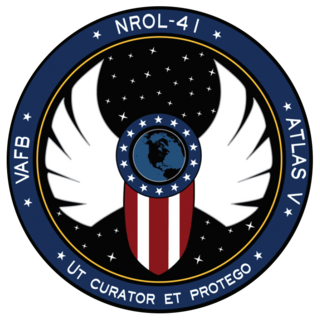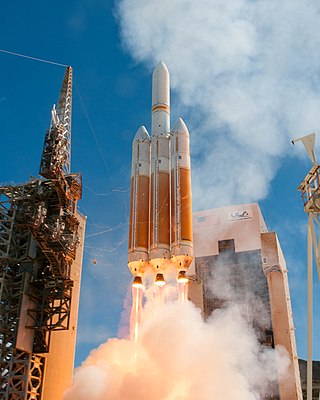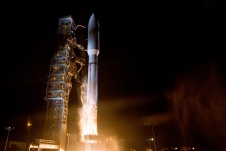
Delta IV was a group of five expendable launch systems in the Delta rocket family. It flew 45 missions from 2002 to 2024. Originally designed by Boeing's Defense, Space and Security division for the Evolved Expendable Launch Vehicle (EELV) program, the Delta IV became a United Launch Alliance (ULA) product in 2006. The Delta IV was primarily a launch vehicle for United States Air Force (USAF) military payloads, but was also used to launch a number of United States government non-military payloads and a single commercial satellite.

The Minotaur is a family of United States solid-fuel launch vehicles repurposed from retired Minuteman and Peacekeeper model intercontinental ballistic missiles. Built by Northrop Grumman under the Space Force's Rocket Systems Launch Program, these vehicles are used for various space and test launch missions.

Vandenberg Space Launch Complex 6 is a launch pad and associated support infrastructure at Vandenberg Space Force Base in California. Construction at the site began in 1966, but the first launch didn't occur until 1995 due to program cancellations and subsequent repurposing efforts.

United Launch Alliance, LLC (ULA) is an American launch service provider formed in December 2006 as a joint venture between Lockheed Martin Space and Boeing Defense, Space & Security. The company designs, assembles, sells and launches rockets, but the company subcontracts out the production of rocket engines and solid rocket boosters.

The Delta IV Heavy was an expendable heavy-lift launch vehicle, the largest type of the Delta IV family. It had the highest capacity of any operational launch vehicle in the world after the retirement of the Space Shuttle in 2011 until the Falcon Heavy debuted in 2018, and it was the world's third highest-capacity launch vehicle in operation at the time of its retirement in 2024. It was manufactured by United Launch Alliance (ULA) and was first launched in 2004. Delta IV Heavy was the last operating member of the Delta IV family, and its final flight was on 9 April 2024. It is succeeded by the Vulcan Centaur rocket.

USA-200, also known as NRO Launch 28 or NROL-28, is an American signals intelligence satellite, operated by the National Reconnaissance Office. Launched in 2008, it has been identified as the second satellite in a series known as Improved Trumpet, Advanced Trumpet, or Trumpet follow-on; a replacement for the earlier Trumpet series of satellites.

USA-212 was the first flight of the Boeing X-37B Orbital Test Vehicle 1, an American robotic vertical-takeoff, horizontal-landing (VTHL) spaceplane. It was launched aboard an Atlas V rocket from Cape Canaveral on 22 April 2010, and operated in low Earth orbit. Its designation is part of the USA series.

USA 202, previously NRO Launch 26 or NROL-26, is a classified spacecraft which is operated by the United States National Reconnaissance Office. It is an Advanced Orion ELINT satellite. According to Aviation Week, it "fundamentally involves America's biggest, most secret and expensive military spacecraft on board the world's largest rocket." The combined cost of the spacecraft and launch vehicle has been estimated to be over US$2 billion.

USA-225, also known as the Rapid Pathfinder Prototype (RPP) and NRO Launch 66 (NROL-66), is an American satellite which was launched in 2011. The satellite is being used to perform technology demonstration and development experiments, including advanced dosimeters to characterize the space environment from a 1,200 kilometer low Earth orbit. It is operated by the United States National Reconnaissance Office.

OTV-2 was the first flight of the second Boeing X-37B, an American unmanned robotic vertical-takeoff, horizontal-landing spaceplane. It was launched aboard an Atlas V rocket from Cape Canaveral on 5 March 2011, and landed at Vandenberg Air Force Base on 16 June 2012. It operated in low Earth orbit. Its USA-226 mission designation is part of the USA series.
USA-227, known before launch as NRO Launch 27 (NROL-27), is an American communications satellite which was launched in 2011. It is operated by the United States National Reconnaissance Office.
USA-229, known before launch as NRO Launch 34 (NROL-34), is a pair of American signals intelligence satellites which were launched in 2011. They are operated by the United States National Reconnaissance Office.

USA-215, also known as NRO Launch 41 or NROL-41, is an American reconnaissance satellite, operated by the National Reconnaissance Office (NRO). Launched in 2010, it has been identified as the first in a new series of imaging radar satellites, developed as part of the Future Imagery Architecture (FIA) programme, to replace the earlier Lacrosse spacecraft.
USA-234, also known as NRO Launch 25 or NROL-25, is an American reconnaissance satellite, operated by the National Reconnaissance Office. Launched from Vandenberg Air Force Base in 2012, it has been identified as the second radar imaging satellite to be launched as part of the Future Imagery Architecture programme.

USA-245 or NRO Launch 65 (NROL-65) is an American reconnaissance satellite which is operated by the National Reconnaissance Office. Launched in August 2013, it is the last Block 4 KH-11 reconnaissance satellite, and the last official spacecraft to be launched in the Keyhole program.

USA-247, also known as NRO Launch 39 or NROL-39, is an American reconnaissance satellite, operated by the National Reconnaissance Office and launched in December 2013. The USA-247 launch received a relatively high level of press coverage due to the mission's choice of logo, which depicts an octopus sitting astride the globe with the motto "Nothing Is Beyond Our Reach". The logo was extensively criticized in light of the surveillance disclosures in July 2013.











